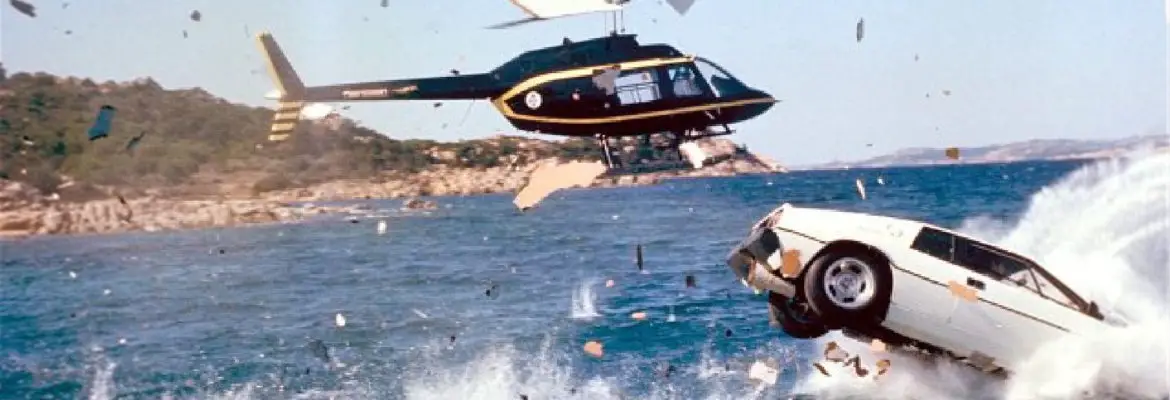The Lotus Esprit Submarine Car: The Definitive Behind-The-Scenes Look At 007’s Ultimate Gadget In ‘The Spy Who Loved Me’

Learn the entire process behind the creation of 007’s ultimate gadget, and why the car was so important for Roger Moore’s Bond and the future of the entire Bond series.
In 1977, the Lotus Esprit submarine car made a huge splash in The Spy Who Loved Me. The car takes center stage in a mountaintop chase in Sardinia before driving off a pier into the ocean depths. Underwater, the wheels roll back and fins extend in their place as the car makes its transformation into a submersible.
The submarine car is part of a legendary collection of Bond vehicles, but more than that, the car has an important association with the film’s star, Roger Moore, and in reinvigorating the Bond franchise. After the poor box office performance of Moore’s second Bond outing, The Man With the Golden Gun, efforts were made to rebrand Bond to suit Moore’s modern and tongue-in-cheek take on the character. In his first two Bond films, the producers tried to incorporate some of Connery’s brutish traits into Moore’s performance, which didn’t suit the actor’s personality. On Spy, he would finally make the role his own when producer Albert R. “Cubby” Broccoli finally capitalized on Moore’s unique brand of humor and emphasized the playboy aspects of 007.
Central to this rebranding exercise was a new car.
Branding the Lotus Esprit to Roger Moore’s Bond
In the mid-1970s, the Lotus Esprit S1 was a modern car for a modern Bond. The Lotus Esprit S1 ranked as one of car designer Giorgetto Giugiaro’s origami-style ‘folded paper’ designs. The car was originally named the Kiwi before being changed to Esprit in keeping with Lotus’ lineup of car model names beginning with the letter ‘e’.
At the time, the Lotus Esprit S1 was without a doubt Britain’s most advanced sports car reaching a purported top speed of 138 mph (222km/h) and weighing at under 1,000 kg. With its sleek look and lowered fibreglass body on an F1-derived chassis and suspension, the Lotus Esprit S1 was distinctive enough to distance Moore from Sean Connery and his Aston Martin DB5.
On a superficial level, cars are part of a person’s image. In film, the connection between the hero and the car he drives is even more overt. Batman has his Batmobile, and Bond has his Aston Martin DB5. Today, the DB5 is associated with James Bond, due to its ubiquitous presence across the films of Pierce Brosnan and Daniel Craig. But back in the Sixties and Seventies, the Aston Martin DB5 was Sean Connery’s car. Moore, as the first real contender to follow the Scottish actor, needed a new car to distinguish himself from Connery. And this is how Roger Moore became the only Bond actor to never sit behind the wheel of an Aston Martin.
The Lotus Esprit S1 not only reflected a modern Bond, it also represented a modern, forward-thinking Britain. Not just technologically, but in the country’s ability to adapt to social and political changes and, thus, remain relevant on the world stage. As promotional shots for The Spy Who Loved Me in 1976 show, the Lotus Esprit S1 was a new car that was somewhat symbolic of Bond’s new attitude towards feminism and glasnost. Leaning against the car is Bond, shoulder-to-shoulder with his new ally, Major Anya Amasova (Barbara Bach), a topnotch female Soviet spy. In the film, Amasova helps Bond dispatch their underwater assailants with the car’s gadgets because she knew which buttons to push after stealing the car’s blueprints two years earlier.
This new détente between East and West–and male and female–was never a feature of Sean Connery’s Bond films, as indicated by the promotional shots of a solitary Connery next to the classic Aston Martin DB5 for Goldfinger. On the other hand, the 1976 promotional shot of Moore is representative of a Bond who is comfortable working alongside a capable woman. Bond’s attitude towards women still needed to improve, but Spy is a significant step forward. He’s no longer slapping women around, which is one cringe-worthy and dated aspect of the Bond films from 1962 to 1974. With The Spy Who Loved Me, Moore finally shrugged off the last vestiges of Connery’s performance and set Bond up for the next decade.
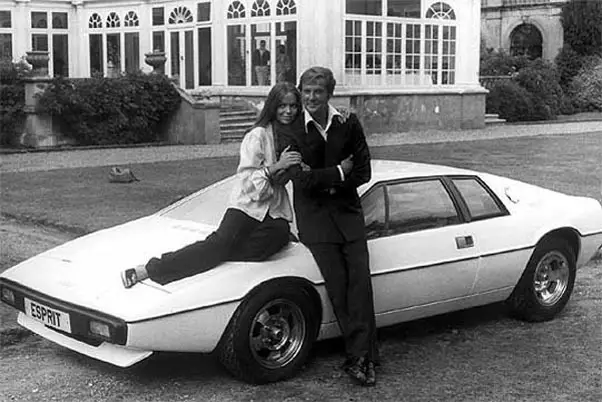
Roger Moore (James Bond) and Barbara Bach (Major Anya Amasova) pose with the Lotus Esprit S1 sports car on the lawn at Pinewood Studios (c. 1976). Source: MovieStillsDB.com
Lotus Engineering Lures James Bond
As for how the Lotus Esprit came to be Bond’s car of choice, legend has it that Don McLauchlan, Lotus’s Head of Public Relations during the 1970s, saw an opportunity to get producer ‘Cubby’ Broccoli’s attention and beat out the competition. He parked a Lotus Esprit outside the producer’s office at Pinewood Studios with all badges and emblems covered up. He got out and waited out of sight. A crowd soon gathered, which included the Bond producer. Then without a word McLauchlan nonchalantly walked over to the car, got in, and drove off. Broccoli just had to find out who made the futuristic sports car, and thanks to McLauchlan’s nifty marketing ploy, Lotus usurped Aston Martin as 007’s new car. However, Peter Lamont, Spy’s Supervisory Art Director, said this story is nonsense, and it was production designer Ken Adam who called Lotus Engineering directly after seeing the car in a magazine.
Whatever the story, the car’s appearance in The Spy Who Loved Me was good for Bond and Lotus. After the film’s release, Lotus sales went through the roof and prospective owners had to be put on a three-year waiting list.
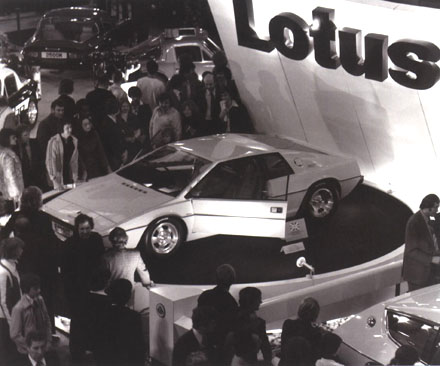
Lotus Esprit S1 unveiled at the 1975 Paris Motor Show.
Designing The Lotus Submarine Car
The submarine car went through several transformations in the early drafts of The Spy Who Loved Me. But turning an idea from a screenplay into an aesthetically pleasing and functional contraption is no small feat. With the Lotus Esprit S1 selected, production designer Ken Adam designed the car’s modifications and packed it full of gadgets. Later, Derek Meddings, the Special Effects Coordinator, would oversee the construction of mechanized models and miniatures from Adam’s beautiful designs.
The submarine car is actually rooted in reality. Aquatic and watertight cars do exist, but none can submerge. They are amphibious craft that are more like boats and nothing like submarines. The most famous is the Amphicar, which appeared in a US Pepsi Cola ad and in the 1967 spy spoof, The President’s Analyst. The German-made Amphicar sold mainly in the US from 1961 to 1968.
Broccoli most likely knew of the Amphicar’s existence, as he had a tendency to incorporate the latest technology into the Bond films. However, the Amphicar wasn’t much to look at. Even a suave British agent cannot make something that resembles a floating bathtub look good. The Lotus Esprit S1, with its sleek aerodynamic lines, looked like it could transform into a slick-looking submersible. However, Meddings recalled that neither he nor Adam knew much about aquadynamics. The car just seemed sleek enough to glide underwater. To increase the Esprit’s streamlined look, Adam’s design featured fins that replaced the wheels after they folded up inside the body.
While the Lotus Esprit submarine car is a unique gadget, it’s also influenced by two previous Bond vehicles–the Aston Martin DB5 in Goldfinger and the Wallis WA-116 Agile autogyro in You Only Live Twice. The Lotus Esprit followed the Aston Martin DB5 as Bond’s second trick car packed with gadgets. In Goldfinger, the gadgets concealed within the DB5 included machine guns behind the headlights, an oil slick dispenser out the taillights, revolving number plates, and a passenger ejector seat.
A couple of films later, in You Only Live Twice, audiences were introduced to Bond’s natty mini-helicopter. Dubbed “Little Nellie”, the autogyro dispatched four machine-gun totting helicopters with its arsenal of air-to-air missiles, rockets, aerial mines, two front machine guns, and two aft flame throwers.
The Lotus Esprit S1 only emulated one gadget (the oil slick) from the DB5 and added a unique one of its own (a rear-mounted concrete sprayer). Most of its arsenal is influenced by “Little Nellie”, with the mini-copter’s gadgets rejigged for the Lotus’ underwater antics. Aerial mines became underwater mines; rockets became harpoons concealed above the front license plate, and the air-to-air missile became a surface-to-air missile that destroyed an enemy helicopter. During production, the crew even nicknamed the Lotus Esprit “Wet Nellie” as a homage to the autogyro in You Only Live Twice. The nickname isn’t mentioned in the film, but it did end up in the film’s novelization, James Bond, The Spy Who Loved Me.
Filming the Sequence
The final sequence is a two-parter (on land and at sea) shot in two countries. In Sardinia, the second unit, led by John Glen (who later directed five Bond films), shot the mountaintop chase. The road chase was shot on a stretch of coast road at Vista Point, and on the small piazza of San Pantaleone, to the southwest. Bond’s Lotus takes a dive off a pier at Liscia di Vacco, and it comes ashore on the beach at Romazzina, on the coast east of the Cala di Volpe.
All the underwater photography, which included a full-scale “wet” submersible and various mechanized models and miniatures, was shot in the open sea off Nassau in the Bahamas. The sequence was overseen by Michael G. Wilson, “Cubby” Broccoli’s stepson and current co-producer of the series. Deputized were veteran underwater photographer, Lamar Boren, and Derek Meddings. Boren, who shot underwater sequences on past Bond films, returned to film the sequences featuring a fully-functional and full-size Lotus Esprit submersible, while Meddings’ special effects unit filmed all the miniatures and mechanized models of the Lotus Esprit submarine. This underwater sequence only lasts 3 minutes on screen but took 70 technicians three months of pre-production and five weeks of filming to finalize.
Before we delve into specifics of the land and underwater chase, watch the full sequence below.
11 cars and Six Body Shells
Lotus Engineering shipped a number of operational Esprits and car shells to EON Productions for Spy. Though sources vary in the number provided, at least one roadworthy car was used for the mountaintop chase in Sardinia, and another Esprit was cut in half so both Roger Moore and Barbara Bach could be filmed in their respective seats. A 2019 episode of Motor Trend’s Auto/Biography television series, states that Lotus Engineering supplied 11 cars, including six body shells for underwater shots. Derek Meddings stated in a 1979 interview with American Cinematographer that six body shells were used just for the transformation of the car into a submarine.
The first body shell was equipped with wheels and a steering column for the moment when the Esprit drives off the pier. Because it had no motor, the car was fired into the sea at 60 mph by a compressed air ram.
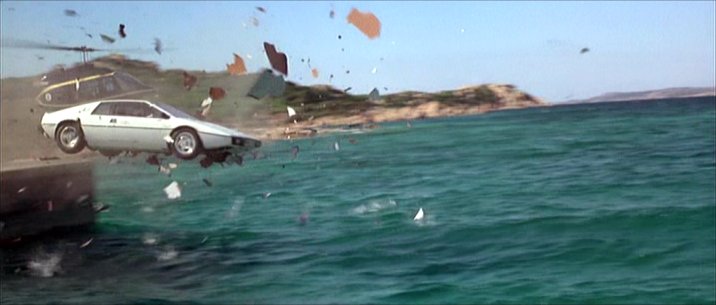
Then, different full-size body shells were used, one for each step of the transformation from car to submarine including:
- the retraction of wheels
- the sliding down of panels over the space left by the wheels
- the projection of fins in their place
- the emergence of a periscope
Each of the above transformations functioned by hydraulic systems operated by a technician within the Lotus car shells.
Other car shells were used for one-off effects shots, including one fitted with a mock-up of a surface-to-air missile shooting out of the roof to destroy the pursuing helicopter. Each of these shells was modified by the special effects crew at Pinewood Studios.
Perry Oceanographic Builds A Functioning Car Submarine
The most important car shell was converted into a fully-functioning submersible. After the special effects crew at Pinewood equipped it with an oil slick and mine laying panel, Meddings shipped the car shell to Perry Oceanographic, who converted it into the sub. The Miami-based underwater engineering firm, which built submarines and underwater scooters for the US Navy, installed ballast tanks, four propellers, fins, and four watertight battery-operated motors into the Esprit. When done, these special modifications topped $100,000 (about $450,000 today).
Like any submersible, the craft was piloted by humans, who could perform maneuvers such as turning, banking, climbing, and even turning the car-sub on its own radius. The craft could reach a top speed of 10 knots, and travel to a depth of 13 m (42 ft). In almost all respects the Lotus Esprit submarine car exceeded the performance of existing commercial underwater vehicles at the time.
But it had its limits. It had poor visibility and it didn’t have a watertight compartment for a driver. “When you build something that has an air compartment, you have problems with ballast”, said Adam. “You’re faced with the problem of continually pumping ballast in and out of the car. And that was something we wanted to avoid.”
Two scuba divers, including a retired U.S. Navy Seal, operated it. While louvers covered the windscreen to give the impression of strengthening the glass from water pressure, the real reason was to conceal the masked and goggled drivers from view in the final scene. The only telltale sign of their existence was the trail of bubbles from their regular aqualungs. This proved fine, however, after Adam and Meddings realized that without any bubbles the car lacked conviction. (A huge cache of Alka-Seltzer tablets created a trail of air bubbles streaming from the miniatures for continuity).
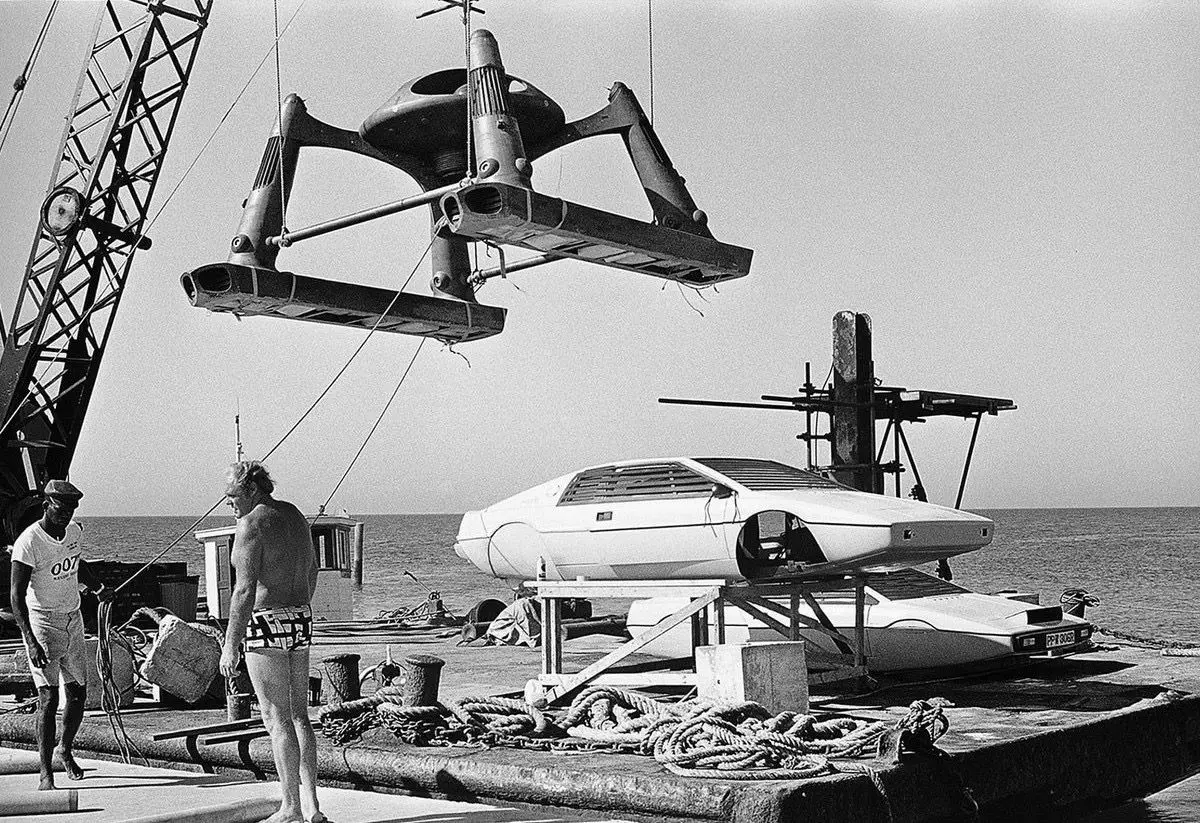
Two Lotus Esprit S1 body shells used in the underwater conversion scene from car to submarine, and for firing harpoons. A scale miniature of the villain’s underwater lair, Atlantis, dangles overhead from a crane. (Source: The Prop Gallery)
Combining Meddings’ Miniatures With Shots Of The Full-Size Esprits
In addition to these full-size, mechanized Lotus shells, Meddings and his team devised several miniaturized models of the underwater car, which ranged in size from six inches to four feet. The underwater sequence frequently cuts back and forth from a full-size car to a miniature. The very first miniature used is the first shot of the car sinking underwater after launching off the pier. Moments later, the sequence cuts to the close-up shots of the different full-size Lotus body shells going through the various transformations from car into submersible.
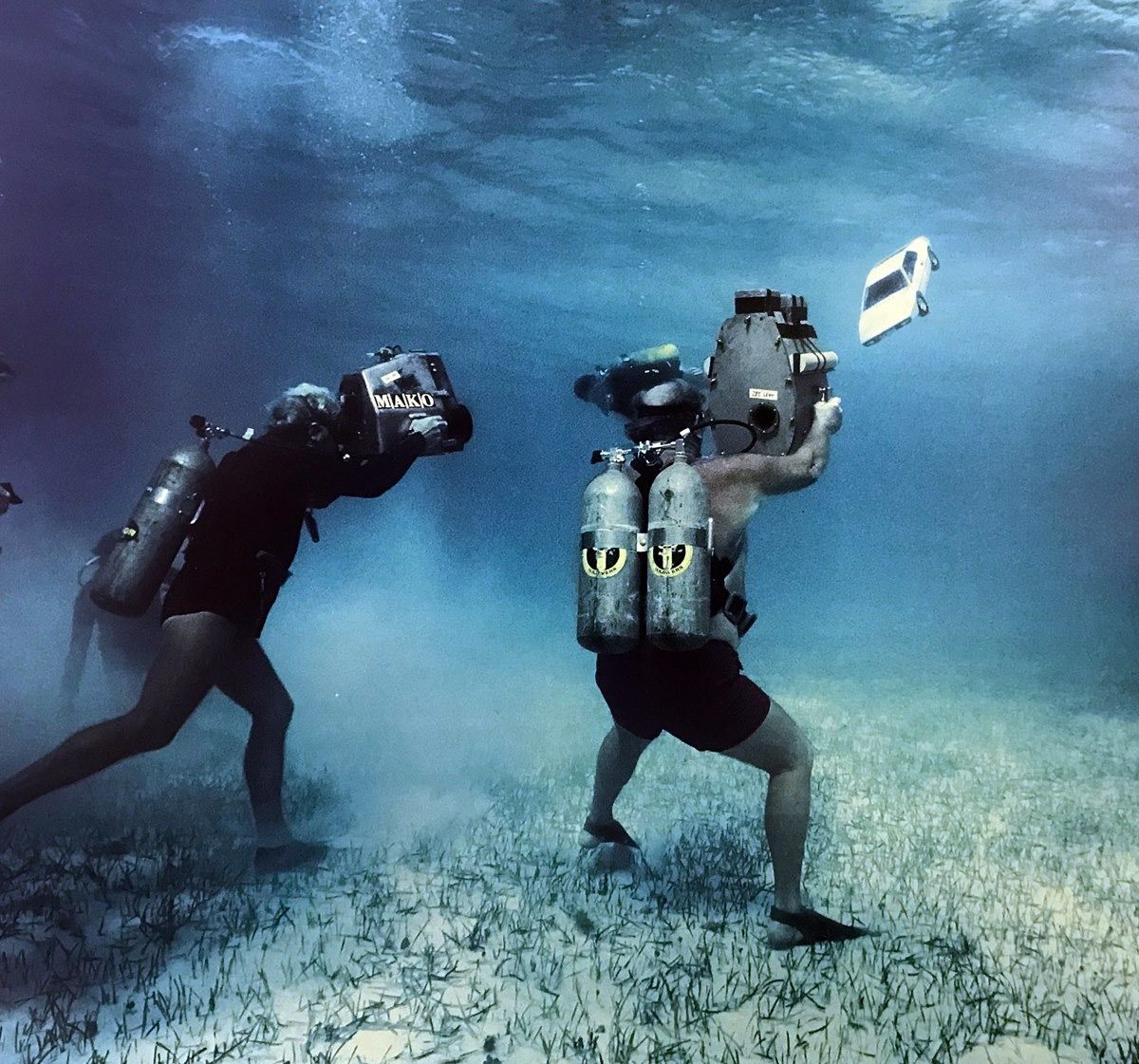
A miniature Lotus Esprit sinking. This is the first shot of the Lotus Esprit underwater. Some sources state this shot was filmed in a test tank, but Meddings told American Cinematographer in 1979 that it was shot in the open sea off Nassau, which this photo seems to confirm.(Source: The Prop Gallery)
The car also appeared alongside miniatures of other vehicles and various background elements and other full-size craft. Below, four scenes are broken down to demonstrate this combination of full-scale models and miniature cars and background elements shot within the natural environment.
Bond fires a surface-to-air missile from the rear of the Lotus Esprit which blows up the helicopter
This part of the sequence involved a full-size mechanical model of the Lotus Esprit and the missile. For the exploding helicopter, Meddings cut from a full-size helicopter to an identical five-foot radio-controlled model which was blown to smithereens on cue.

Bond and Amasova travel underwater in the Lotus Esprit submarine, approach the submerged Atlantis, and hover over its control room.
Shots of the full-size mechanized Lotus Esprit by Perry Oceanographic were used for traveling over reefs and through the water. But shots of the car approaching the villain’s underwater lair, Atlantis, were all achieved with several different sized Lotus submarine miniatures. In addition, Meddings used different scale models of coral reefs and Atlantis, including a scale model of one of its legs, as background elements. The control room, which is visible through a porthole in Atlantis, was a matte painting with footage projected on it.

Veteran underwater photographer, Lamar Boren, who shot underwater scenes for Thunderball and You Only Live Twice, films the submersible, “Wet Nellie”. Source: MovieStillsDB.com
After the Lotus Esprit exits from Atlantis, frogmen on underwater scooters emerge from a full-size section of Atlantis and together, with a mini-sub, give chase. A fight ensues involving underwater rockets fired by the scooters, the Lotus, and the mini-sub.
All underwater craft were full-scale mechanical devices specifically designed for the film, except for the mini-sub. The mini-sub already existed and was specifically modified to carry and fire torpedoes for the film. The rockets, the ink, and the mines were all worked by operators inside the Lotus.
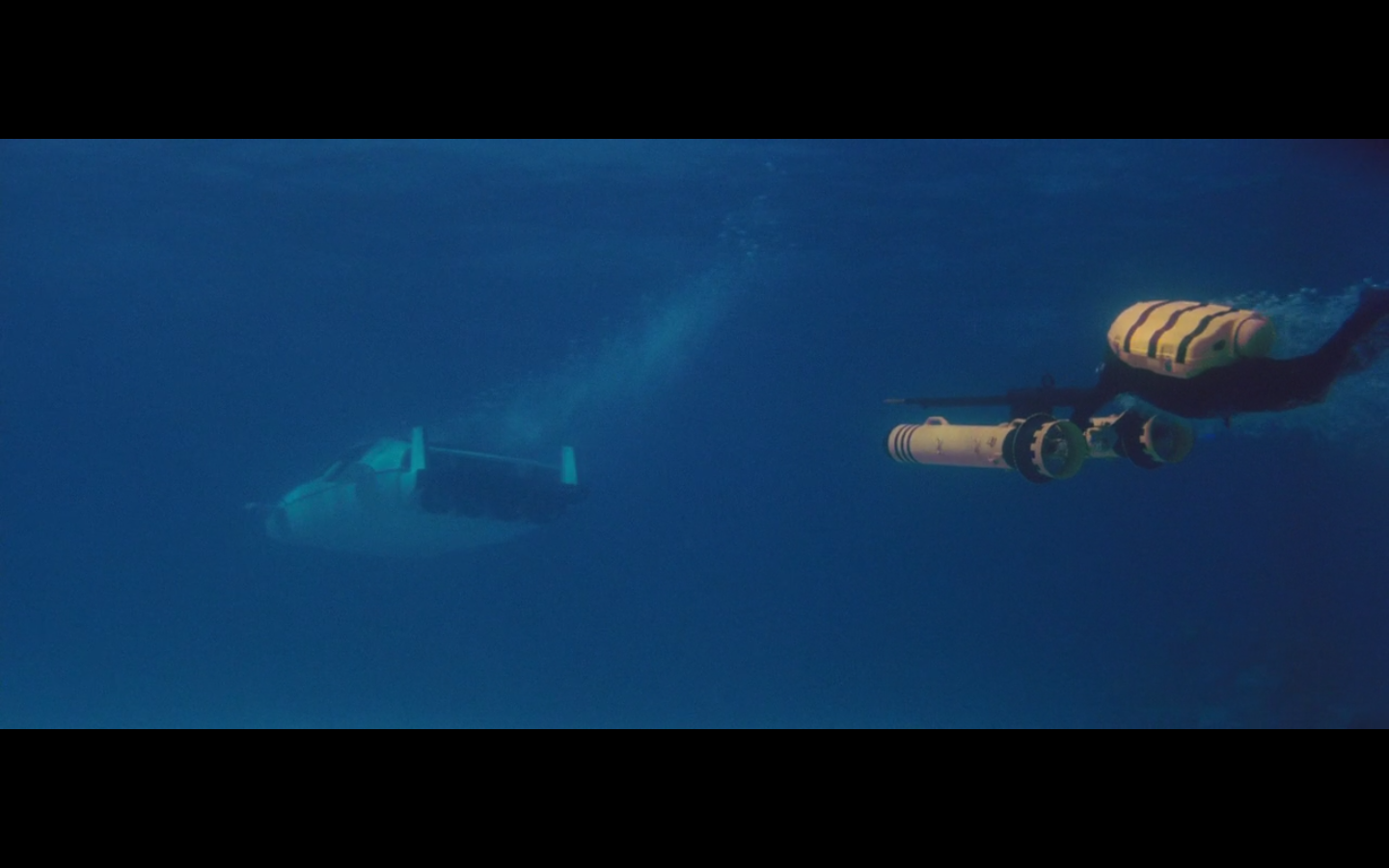
Following the underwater battle, the leaking Lotus Esprit hits the seafloor and then surfaces on a beach.
The ending of the sequence involved the self-propelled Lotus Esprit submersible hitting the seafloor. Then, the scene cuts to a full-size model slowly emerging to the surface via a tow rope and a hidden mechanical track. Finally, a road-worthy Lotus was driven from the beach.
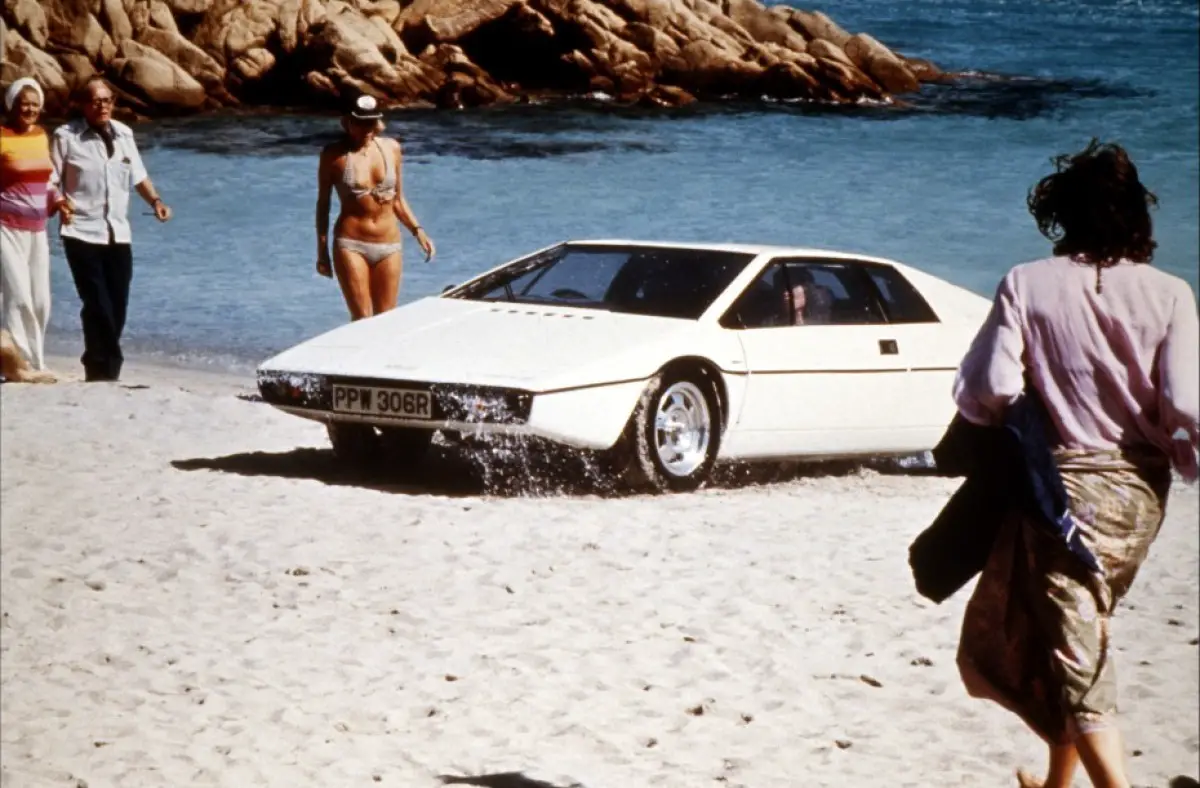
The beach sequence was shot on October 5 and 6, 1976 in Capriccioli, Sardinia. That was off-season for Sardinia when the beaches were empty of tourists. Source: MovieStillsDB.com
Mountaintop Mechanized Models In Sardinia
Specially outfitted models and miniatures were not only limited to the underwater scenes. Bond’s car was also put through its paces on land by a motorcycle, helicopter, and a number of cars, which all had help from the special effects department.
Memorably, the mountaintop chase begins with a motorcyclist in hot pursuit on a Kawasaki Z900 with a sidecar. This part of the sequence begins in San Pantaleo and continues along the Costa Smeralda in Sardinia.
The motorcyclist fires what appears to be an unmanned sidecar missile which narrowly misses the Lotus and slams into the back of a truck. In actuality, the sidecar was a working vehicle, custom-built to carry a stuntman, who lay face-down in the contraption. Adapted by Pinewood’s special effects team with two-inch scooter wheels on each side and a Suzuki 185 engine, the sidecar could be steered by the concealed stuntman using a small solid rubber wheel at the front. A smoked Perspex nose doubled as a windscreen while also concealing him from view.
Although the pilot uncoupled the projectile from the bike via a solenoid switch, the motorcyclist helped acceleration by pressing an ignition switch that activated rear-mounted rockets on the sidecar. Unfortunately, the sidecar only traveled 20 miles per hour and the footage was sped up during the editing process to convince the audience of its deadliness.
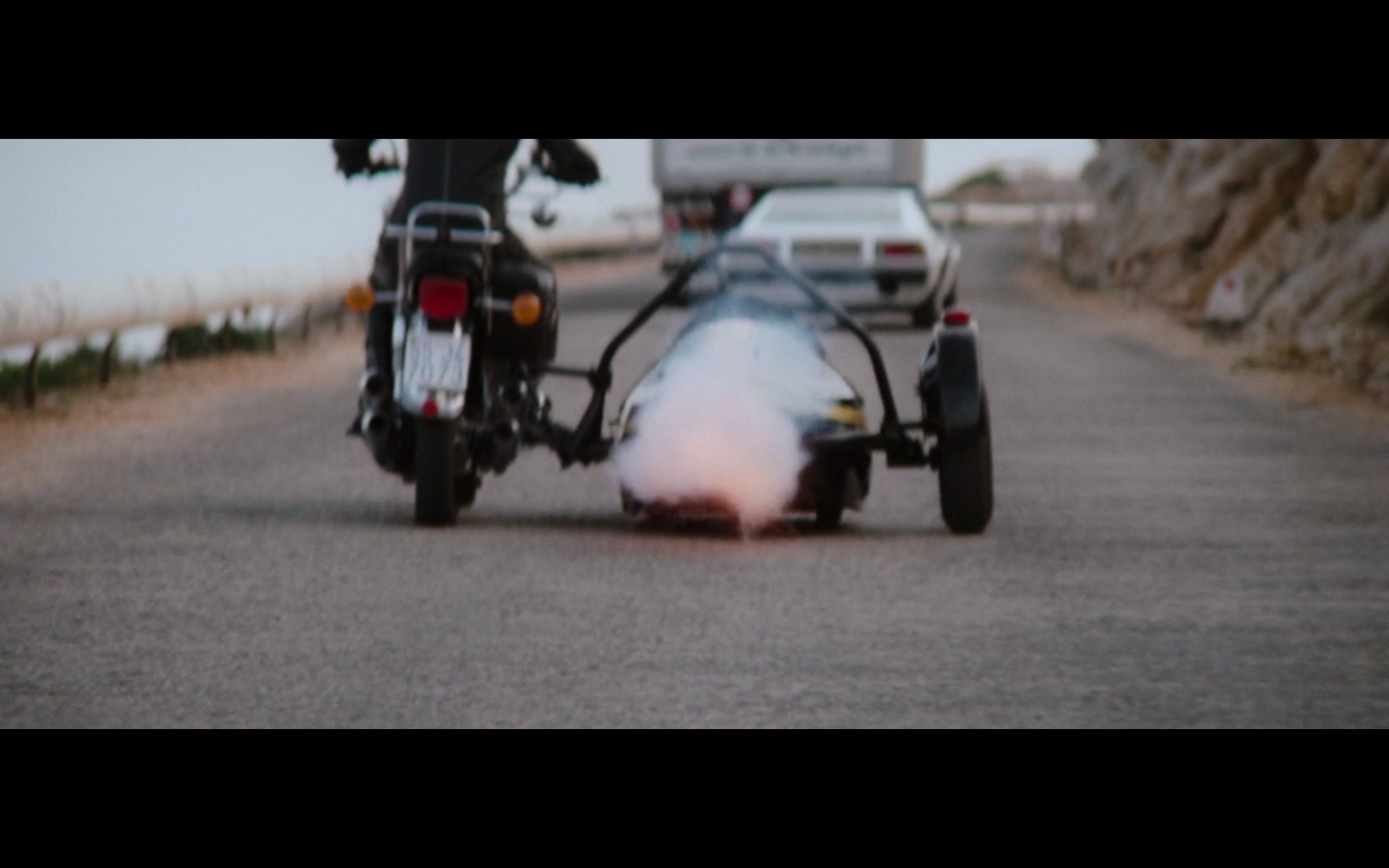
The Lotus Esprit S1 Proves Problematic On Land
The Lotus Esprit S1 looked the part, had a great sounding engine, and performed well as a submersible, but on land it was problematic. Not only did it stall easily–and frequently–but it also held the corners too well, failing to provide the necessary skid of a high-speed chase.
Roger Becker, a Lotus Engineer, and test driver, had been tasked with delivering the car to Sardinia in September 1976, and then to help the stunt driver become ‘at one with the car’ and its handling. But the stunt driver was ill at ease with handling the Lotus Esprit, and the film crew became frustrated with him.
Then when the crew was set to film a difficult stunt involving the Esprit driving up a hill and swerving around a bend, the stuntman failed to show. The filmmakers convinced Becker to get behind the wheel and perform the stunt without the cameras rolling to see what he could do.
Not only did he perform well, he exceeded expectations when he spun the Esprit a full 180 degrees to a controlled stop on the hilltop. John Glen, Spy’s second unit director, was amazed, and Becker spent the next seven weeks doubling as the other Roger, Roger Moore, in every action moment featuring the Esprit, except when it was a submersible.
The Lotus Esprits continued to be problematic as Roger Moore recalled in his book, Bond on Bond:
“During filming, their engines overheated and batteries ran down quickly. Their low driving position made elegant exits from the car an issue, and all this made the action location in Sardinia a little fraught.”
Lotus Returns in For Your Eyes Only
Nonetheless, Lotus continued its association with James Bond for one more Bond film, For Your Eyes Only. The twentieth film is more down-to-earth than The Spy Who Loved Me. This time two Lotus’s appeared, and they were the new–and improved–Lotus Esprit Turbo. Unveiled in February 1980, Lotus sent their original prototype (chassis 10858) and an early production car (chassis 10930) to Bond film company, EON Productions.
While the car’s gadgets were less advanced than the submarine car in Spy, the white Esprit Turbo’s spontaneous combustion after a thug broke in, seemed a slightly excessive security system.
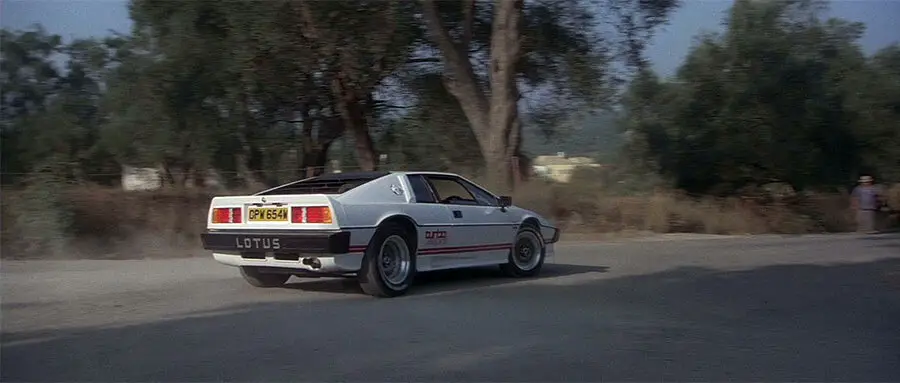


Thankfully, Bond was back in another Esprit Turbo later in the film on location in the Italian resort of Cortina. Broccoli had the white car painted ‘Copper Fire Metallic’ with gold stripes and decals. The darker color was more suitable against the white landscape. This car was subjected to a more leisurely pace than before–its only gadgets were a pair of custom ski racks mounted over the engine cover. It also gave Moore less grief to drive than the Lotus Esprit S1 in Spy. Apparently, off-camera, Moore drove it around the Italian resort between takes as his leisurely car of choice.
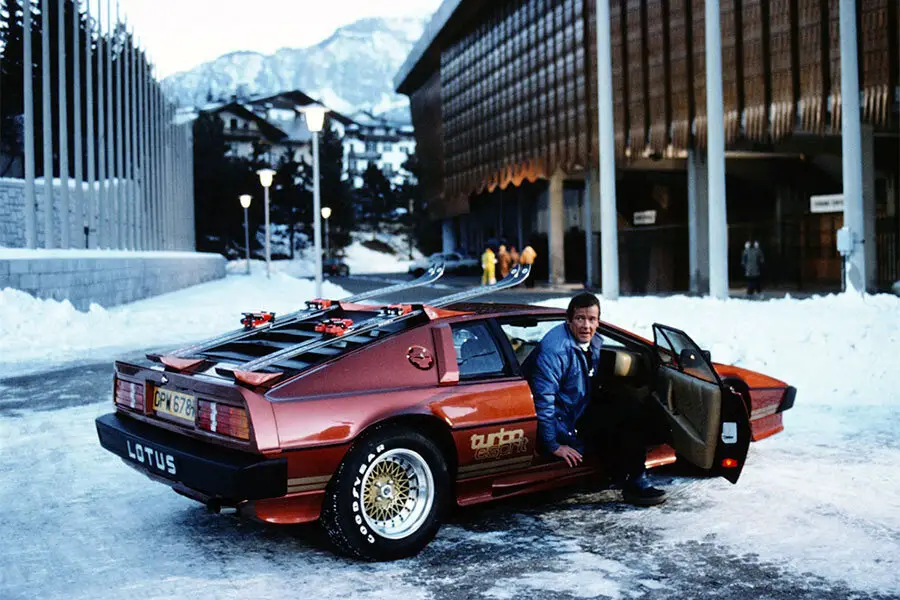
Lotus Esprit featured in two Roger Moore Bond films and is yet to reappear as Bond’s car of choice. It’s two appearances parallels the appearance of the Aston Martin DB5 in Goldfinger and Thunderball for Sean Connery, but if it wasn’t for its transformation into a submarine, the Lotus Esprit might be all but forgotten.
Elon Musk Now Owns The Lotus Esprit Submarine Car
The Lotus Esprit submarine car’s life is far from over. In 2013, billionaire Elon Musk purchased the original submersible from RM Sotheby’s for $997,000. He said he’s determined to make it work, which includes re-engineering the car so it legitimately transforms from a car into the submersible. He also intends to make a watertight compartment to sit in. Not much progress has been reported since, but Musk did say that the car served as inspiration for Tesla’s new Cybertruck.
While the real-life Tony Stark may have designs on becoming a real-life James Bond, the Lotus Esprit submarine car will always remain Roger Moore’s car.


